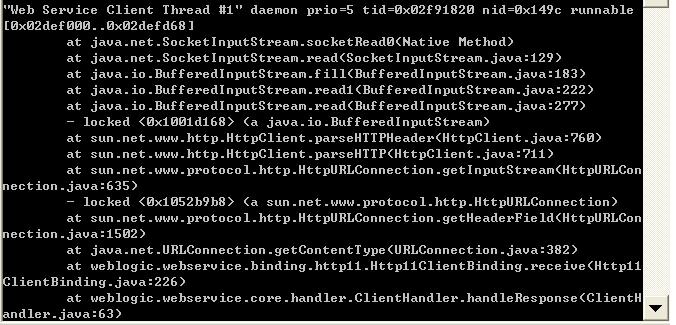這幾天碰到個問題:在weblogic中調用async webservice,如果客戶端不等待結果(比如服務器端因為某些原因,web service需要執行很長時間),直接退出的話,weblogic server是否保存調用結果,結果保存多長時間?如果這樣的異常客戶端很多,對服務器有什麼負面影響,比如連接資源、內存開銷等。
首先我們先闡述一下異步的概念 在weblogic webservice中,有兩處異步的概念:
1:Synchronous request-response (the default behavior) means that every time a client application invokes a Web Service operation, it receives a SOAP response, even if the method that Choosing RPC-Oriented or Document-Oriented Web Services Programming WebLogic Web Services 4-3 implements the operation returns void. Asynchronous one-way means that the client never receives a SOAP response, even a fault or exception.
默認情況下,weblogic webservice是請求-應答模式的,即客戶端會block當前線程,直到server端處理完該請求(即使該請求沒有任何返回值,void)。當 web service不返回結果,客戶端只是提交請求,不需要知道執行結果的時候,可以采用異步單向模式。這種情況下,客戶端線程為非阻塞的,它只負責提交請求,而不需要返回結果。定義這樣的異步web service時,需要遵循如下的兩個原則:
1.1:The back-end component that implements the operation must explicitly return void.
1.2:You cannot specify out or in-out parameters to the operation, you can only specify inparameters.
2:This section describes how to invoke an operation asynchronously. In this context, asynchronously means you invoke an operation and then optionally get the results of the invoke in a later step.
這種情況下雖然也是異步調用的,但這種調用方式客戶端需要返回值。需要返回結果,但客戶端又不樂意阻塞在服務器端請求處理上(可能服務器端處理該請求需要很長時間)。客戶端希望繼續執行它的其他業務邏輯,需要執行結果的時候,我在過來取這個結果。這樣可以提高客戶端的響應速度。
這篇文章,我們主要看看2這種情況。
2.1: web service開發
開發web service不存在任何區別,但在build client jar的時候,需要在調用clientgen的時候加上generateAsyncMethods = true, 這樣clientgen生成的JAX-RPC stub中會多出兩個方法,如下:
FutureResult startMethod (params, AsyncInfo asyncInfo);
result endMethod (FutureResult futureResult);
其中:Method對應於web service中的方法名,如sayHello---->startSayHello(params, AsyncInfo asyncInfo)。這兩個方法就是我們客戶端代碼中異步調用的時候需要的。
2.2:客戶端代碼
客戶端代碼有兩種寫法,一種是客戶端線程主動調用FutuerResult.isCompleted()來檢查web service請求是否執行完成,另一種方式是通過Listenter來處理服務器端的返回結果。
//client thread checking
1 public void runUnblock(){
2 initializeEnv();
3 try{
4 System.out.println(port.getClass().getName());
5 FutureResult result = port.startSayHello(3, "test", null);
6 //you other business logic here
7 if(result.isCompleted())
8 {
9 String ret = port.endSayHello(result);
10 System.out.println("result from remote HelloWorld web service: ");
11 System.out.println(ret);
12 }
13 }catch(Exception e){
14 e.printStackTrace();
15 }
16 }
17
18 public void initializeEnv(){
19 try{
20 helloService = new HelloWorld_Impl();
21 port = helloService.getHelloWorldPort();
22 }catch(Exception e){
23 e.printStackTrace();
24 }
25 }
//listener
1 AsyncInfo asyncInfo = new AsyncInfo();
2 asyncInfo.setResultListener( new ResultListener(){
3 public void onCompletion( InvokeCompletedEvent event ){
4 SimpleTestSoap source = (SimpleTestSoap)event.getSource();
5 try{
6 String result = source.endEchoString ( event.getFutureResult() );
7 } catch ( RemoteException e ){
8 e.printStackTrace ( System.out );
9 }
10 }
11 });
12 echoPort.startEchoString( "94501", asyncInfo );
現在回頭看看開篇的問題,客戶端線程退出時,如果服務器端還沒有處理完,請求結果會怎麼辦?是否會保存下來?如果這樣的客戶端很多,服務器內存開銷豈不是很大?
要解釋這個問題,我們先來看看這種調用方式的流程。對於服務器而言,異步、同步調用是一樣的,它只負責接收、處理請求,web service的處理,在服務器端是由weblogic.webservice. server.servlet. WebServiceServlet .serverSideInvoke(WebService webservice, Binding binding, HttpServletRequest request, HttpServletResponse response)。同步、異步的處理完全是在客戶端完成的,下面就看看客戶端的調用流程。
FutureResult result = port.startSayHello(3, "test", null);
//it's a JAX-RPC stub, and it extends StubImpl.java
====>
weblogic.webservice.core.rpc.StubImpl._startAsyncInvoke( String method, Map args, AsyncInfo wsAsyncContext )
//in this method, Operation is retrieved from Port
====>
weblogic.webservice.core.DefaultOperation.asyncInvoke( Map outParams, Object[] args, AsyncInfo wsContext, PrintStream logStream )
//a ClientDispatcher is created here and then we dispatch our requst with this dispatcher
====>
weblogic.webservice.core.ClientDispatcher.asyncDispatch(final Object[] args, final AsyncInfo async)
//in this method, FutureResultImpl is created and it will be returned to client. It's responsible to send message and
//receive response from server in another. For receiving response, it's will be discussed later.
====>
weblogic.webservice.core.ClientDispatcher.send(Object[] args)
//MessageContext is set(for example, BindInfo is set) here and the request will be handle by a handler chain.
====>
weblogic.webservice.core.handler.ClientHandler.handleRequest(MessageContext ctx)
//it check bind info and the delegate the request to binding
====>
weblogic.webservice.binding.http11.Http11ClientBinding.send(MessageContext ctx)
//it retrieve endpoint from bindinfo and then open a HttpURLConnection with the URL created basing on endpoint.
//Reqeust is sent to server with this HttpURLConnection.
1 connection = (HttpURLConnection)url.openConnection();
2
3 outputStream = connection.getOutputStream();
4 request.writeTo( outputStream );
請求發送完了,交給服務器去執行,下面我們再來看看客戶端是如何處理response的。weblogic.webservice. core.ClientDispatcher.asyncDispatch()中,請求發送結束後,weblogic將啟用一個新線程來接受服務器的 response,如下:
1 getThreadPool().addTask(new Runnable() {
2 public void run() {
3 callReceive(messageContext);
4 }
5 });
注意:這個線程是在客戶端啟動的。該接收線程啟動後,FutureResultImpl實例會返回給客戶端,客戶端由此可以繼續他的業務邏輯,而不必block在等待response上。response由接收線程負責處理,收到response,處理後的結果會被植入 FutureResultImpl,客戶端執行它的其他邏輯,需要處理處理該結果時,只需要檢查請求是否處理結束,如果結束,處理請求結果,如果請求依然沒有結束,則由客戶端決定繼續等待,還是放棄(主線程退出),如下:
1 //you other business logic here
2 if(result.isCompleted())
3 {
4 String ret = port.endSayHello(result);
5 System.out.println(ret);
6 }
客戶端接受流程:
weblogic.webservice.core.ClientDispatcher.asyncDispatch(final Object[] args, final AsyncInfo async)
====>
weblogic.webservice.core.ClientDispatcher.callReceive(WLMessageContext ctx)
//call receive() here, and if response was received, set it to FutureResultImpl that owned by the client and if Listener is configured, trigger the listner.
1 if (listener != null) {
2 InvokeCompletedEvent event = new InvokeCompletedEvent(
3 async.getCaller());
4
5 event.setFutureResult(futureResult);
6 listener.onCompletion(event);
7 }
====>
weblogic.webservice.core.ClientDispatcher.receive(WLMessageContext ctx)
//resoponse is handled by a handler chain
====>
weblogic.webservice.core.handler.ClientHandler.handleResponse(MessageContext ctx)
====>
weblogic.webservice.binding.http11.Http11ClientBinding.receive( MessageContext context )
//read response from the input stream of connect that we send request with, and the thread will be blocked in
//waiting data from server.

好了,基本流程都列出來了。下面據此回答開篇的問題:
1:如果客戶端不等待結果(比如服務器端因為某些原因,web service需要執行很長時間),直接退出的話,weblogic server是否保存調用結果,結果保存多長時間?
不會。如果客戶端退出前,請求已處理,保存在FutureResultImpl將會因為客戶端的退出而銷毀。如果沒有處理結束,服務器端回寫 response的時候,雖然指向客戶端的連接已經因為客戶端退出而close了,但服務器端從該connection中拿到的output stream還在,服務器仍然會將response寫入到該output stream中(這是寫入的數據是沒有接收者的),response寫完後,weblogic會關閉output stream, 並close socket。
2:如果這樣的異常客戶端很多,對服務器有什麼負面影響,比如連接資源、內存開銷等。
不會。如果客戶端退出前,請求已處理,則連接已經釋放。如果連接保持的時間略大於web service請求在服務器段的處理時間。請求處理結束後,服務器會在回寫完response後,主動斷開連接(可以看到客戶端至server端的連接為 TIME_WAIT)。如果客戶端退出時,請求依然在服務器端上處理,客戶端的退出會導致連接的CLOSE。兩種情形都不會因為異常客戶端而導致連接浪費。至於內存開銷,服務器不會保存執行結果,請求處理結束後,直接回寫客戶端,所以也不會造成內存資源leak。
對於那些web service執行時間較長,客戶端又希望其他業務並行的應用,這種異步調用是個不錯的選擇。